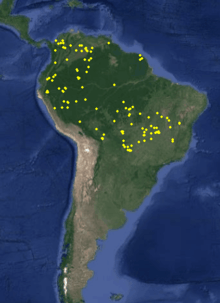Psittacanthus acinarius
Psittacanthus acinarius is a species of mistletoe in the family Loranthaceae, which is native to Bolivia, Brazil, Colombia, Costa Rica, Ecuador, Peru, Venezuela,[4] and French Guiana.[5]
| Psittacanthus acinarius | |
|---|---|
| Scientific classification | |
| Kingdom: | Plantae |
| Clade: | Tracheophytes |
| Clade: | Angiosperms |
| Clade: | Eudicots |
| Order: | Santalales |
| Family: | Loranthaceae |
| Genus: | Psittacanthus |
| Species: | P. acinarius |
| Binomial name | |
| Psittacanthus acinarius | |
 | |
| Occurrence data from GBIF[3] | |
| Synonyms[4] | |
Loranthus warmingii (Eichler) Danser | |
Description
Psittacanthus acinarius has pendulous branches, which are circular in cross-section, except at the apex where the cross-section is slightly quadrangular.[5] There are no epicortical roots.[5] The petiolate, leathery leaves are opposite and of length 10–22 cm and width 6–15 cm, with the leaf base being acute or obtuse, the apex obtuse, rounded, with inconspicuous ribbing.[5] The position of the inflorescence is terminal and has persistent non-fused bracts, with an umbel of pedunculate triads.[5] The external colour of the petals is greenish; the internal colour is red and they have a straight style.[5] The buds are long and straight with a dilated base and an acute apex.[5] The stamens are dimorphic. The anthers are red and 7–8 mm in length.[5] The stigma is globose and red.[5] The fruit is ellipsoidal or ovoid, of length 20 mm, width 10 mm long, and when immature is reddish, and when ripe black.[5] The seed has 4-6 cotyledons.[5]
The terminal position of the inflorescences, the robust and fleshy aspect of the peduncles and flowers, the presence of the dilated sub-floral dome, and the greenish color of the flowers are distinctive characteristics of the species.[5] It presents great variability in leaf format.[5] In Brazil, it is one of the most common mistletoe species.[5]
Distribution
It is found in Bolivia, Brazil, Colombia, Costa Rica, Ecuador, Peru, Venezuela,[4] and French Guiana.[5]
In Brazil, it is found in the Amazon Rainforest, Caatinga, Central Brazilian Savanna, and the Pantanal, inhabiting the vegetation types of Caatinga, Amazonian Campinarana, Cerrado, riverine forest and/or gallery forest, Igapó flooded forest, Terra Firme Forest, Várzea inundated forest), seasonally semideciduous forest, and the Amazonian Savanna.[5]
Taxonomy
Psittacanthus acinarius was first described by von Martius in 1829 as Loranthus acinarius,[6][7] and in 1830, he reassigned it to his newly described genus Psittacanthus.[1][2]
Etymology
Psittacanthos comes from the Greek psittakos (parrot), and the Greek anthos (flower), possibly chosen, according to Don,[8] because of the bright colours. The specific epithet, acinarius, is the Latin for designed for holding grapes.[9]
References
- "IPNI: Psittacanthus acinarius". International Plant Names Index. Retrieved 19 August 2018.
- von Martius, C.F.P. 1830. Flora 13(1): 108.
- GBIF.org (19 August 2018) GBIF Occurrence Download Psittacanthus acinarius Mart.
- Govaerts, R. et. al. 2018. "Plants of the World online: Psittacanthus acinarius". Board of Trustees of the Royal Botanic Gardens, Kew. Retrieved 19 August 2018.
- "Psittacanthus acinarius (Mart.) Mart". Flora do Brasil 2020: Algae, Fungi, Plants, Jardim Botânico do Rio de Janeiro. Retrieved 19 May 2018.
- "IPNI: Loranthus acinarius". International Plant Names Index. Retrieved 19 August 2018.
- von Martius, C.F.P. 1829. "Syst. Veg., ed. 15 bis [Roemer & Schultes] 7(1): 130".
- Don, G. 1834. "A general history of the dichlamydeous plants :comprising complete descriptions of the different orders...the whole arranged according to the natural system 3: 415".
- Online latin dictionary: acinarius Retrieved 19 August 2018.
External links
- von Martius, C.F.P. 1867. Flora Brasiliensis 5(2) p.41, Tab 9.